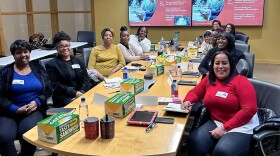Unforgotten is a cross-platform series and podcast chronicling Connecticut's ties to slavery. Learn more.
When people think of slavery in the U.S., many think of the South. But slavery happened in the North — and throughout New England, including Connecticut.
In fact, Connecticut was the last New England state to formally end slavery. Slavery didn't legally end in Connecticut until 1848 — just 13 years before the start of the Civil War. Thousands of people were enslaved in Connecticut. Thousands more were enslaved across New England.
It’s history that many of us didn’t learn in school.
Connecticut Public’s journalists wanted to explore this history: What happened, why it happened and why it matters today. It led to nine months of reporting, which resulted in our special series, Unforgotten: Connecticut’s Hidden History of Slavery.
We’ve interviewed dozens of people: historians, experts, volunteers, families, students and teachers. They helped us tell the stories of some of the men, women and children who were enslaved.
People affiliated with a variety of groups have helped us find these stories — including volunteers with the Witness Stones Project, an educational initiative that aims to “restore the history and honor the humanity of the enslaved.”
Various academic studies, books and media reports in recent years have shed light on slavery in New England. So we realize that some are already familiar with our region’s history of slavery. But we also know that many are likely not aware of these stories.
We wanted to feature people talking in their own words about what the state’s history of slavery means to them. We talked with descendants of men and women who were enslaved in Connecticut. We interviewed them in or near the places where their ancestors lived, worked or are buried.
Reporter/producer Diane Orson initiated this series. Through her work as a musician, she had learned about Sawney Freeman, a musician and composer who was once enslaved in Connecticut; she had an opportunity to play his music. (We feature him in the fourth story in our series.)
While the Connecticut Public content team mostly mirrors the state’s demographics, many of the journalists involved in this series are white. We were mindful of that. We were intentional in centering our reporting on people of color and experts of color. We asked journalists of color to review the stories and offer feedback. We also worked with Frank Mitchell as an editorial consultant for this series. Mitchell is a cultural organizer and on the board of directors for CT Humanities. We turned to him for guidance as we reported and edited the stories. Connecticut Public paid him a nominal fee for his consulting efforts.
Our series includes several videos and a television special; in-depth radio features, a radio special and a podcast; and digital storytelling and social media elements. We’re also hosting a community discussion.
As Adrienne Joy Burns, a public historian, tells us in our first story, learning about this hidden history is beneficial: “Because it helps us to understand how we got here. And that's the important part, because that's what we can change. We can change it when we understand it.”
As you read, listen or watch the stories in this series, we invite you to share your feedback with us. Send us an email at unforgotten@ctpublic.org.
Thank you for taking the time to explore this history.
— Eric Aasen, executive editor, Connecticut Public
Read more from Unforgotten: Connecticut's Hidden History of Slavery
Chapter 2: ‘This is my country': A family learns their ancestors were enslaved in Connecticut
Resources
Featured in this series
Frank Mitchell; Connecticut Explored; Witness Stones Project; Mystic Seaport Museum exhibition: Entwined: Freedom, Sovereignty, and the Sea; Hyland House Museum; St. John’s Episcopal Church in Essex; John Wood Sweet; Cheo Hodari Coker; Waide Communications; Jumoke McDuffie-Thurmond
Sisters in Stitches Joined by the Cloth; Heritage Film Project; the Watkinson Library at Trinity College; Barn Island Wildlife Management Area; Deacon John Grave House; Captain Nathaniel B. Palmer House Museum; East Haddam Historical Society & Museum; First Church of Christ, Congregational in East Haddam;
Guilford Free Library; Stonington Historical Society; the Whitney Library at the New Haven Museum; Old Saybrook Historical Society; James Hillhouse High School; Choate Rosemary Hall
Books
"Complicity: How the North Promoted, Prolonged, and Profited from Slavery," Anne Farrow, Joel Lang and Jenifer Frank, Ballantine Books
"African American Connecticut Explored," edited by Elizabeth Normen, with Stacey C. Close, Katherine J. Harris and Wm. Frank Mitchell, Wesleyan University Press
"Disowning Slavery: Gradual Emancipation and ‘Race’ in New England, 1780-1860," Joanne Pope Melish, Cornell University Press
"Yale and Slavery: A History," David Blight with the Yale and Slavery Research Project, Yale University Press
"Venture Smith’s Colonial Connecticut" (recommended for grades 5-8), Venture Smith, Elizabeth Normen, Connecticut Explored
"The Freedom Business, including a Narrative of the Life & Adventures of Venture, a Native of Africa," poems by Marilyn Nelson, Wordsong
Learn more
Yale and Slavery Research Project
Gilder Lehrman Center for the Study of Slavery, Resistance, and Abolition at Yale University
Credits
Reporter/producer: Diane Orson
Senior director, visuals and television production: Julianne Varacchi
Executive editor: Eric Aasen
Digital editor: Patrick Skahill
Editor, local news programs and podcast: Cassandra Basler
Editorial consultant: Frank Mitchell
Video editing: Ayannah Brown, Ryan Caron King, Mark Mirko, Meghan Lyden
Videography: Ayannah Brown, Ryan Caron King, Mark Mirko, Dave Wurtzel
Motion graphics: Sam Hockaday
Audio: Glenn Goettler, Mike Larini
Social media: Sabrina Herrera, Francesca Fontanez and Shanice Rhule
Editing support: Erica McIntosh and Meg Dalton
Senior director, storytelling and radio programming: Catie Talarski
Chief content officer: Vanessa de la Torre
Senior director, Data and Digital Services Bureau: Susan Bell
Director, digital products and strategic integration: Christian Setterlund
Director, digital projects: Bill Sencio
Digital producer: Jessica Gonnella
Chief digital officer: Lauren Komrosky
Vice president, community engagement: Lucy Nalpathanchil
Feedback
Share your thoughts on the stories in this series via email at unforgotten@ctpublic.org.




